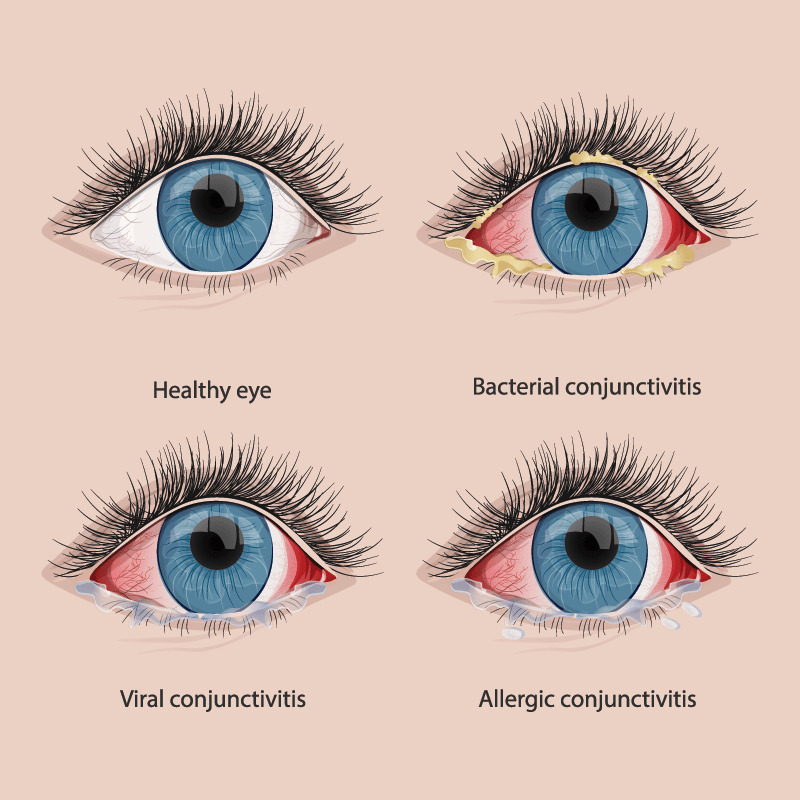Important treatments you need to know about Conjunctivitis.
What is Conjunctivitis?
Conjunctivitis, also referred to as “pink eye,” is an infection or swelling of your conjunctiva, a thin, transparent membrane that covers the white area of your eye and sits over the inner surface of your eyelid.

Your conjunctiva becomes inflamed with blood vessels when you have pink eye. This causes your eye to get red or pink, which is a characteristic of conjunctivitis.
Pink eye might be a pain, but it rarely impairs your eyesight. Pink eye irritation can be reduced with the use of treatments. Early detection and treatment of pink eye can assist in containing its spread because it can be contagious.
Types and causes
Pink eye generally falls into one of three categories:
- infectious
- allergic
- chemical
- bacterial conjunctivitis
Infectious pink eye comes in a few different kinds, including:
- bacterial
- viral
Bacterial Pink Eye: Staphylococcal or streptococcal germs cause bacterial pink eye. It usually happens as a result of activities like using dirty hands to touch your eyes, sharing makeup, or coming into direct contact with someone who might also have conjunctivitis.
Viruses that cause the common cold frequently induce viral pink eye. It could happen if someone nearby sneezes or coughs while suffering from an upper respiratory infection. When you have a cold virus yourself and blow your nose too hard, it might also happen. The infection may spread from your respiratory system to your eyes as a result.
An allergic eye condition
Seasonal allergies are the main cause of allergic pink eye. If they come into touch with an allergen, such as pollen, they may develop pink eye.
If you wear hard contact lenses or soft contact lenses that aren’t changed frequently enough, you could possibly have large papillary conjunctivitis, an allergic form of pink eye.
Conjunctivitis due to chemicals
Pink eye can be brought on by irritants like:
- pools with chlorine
- air toxicity
- other chemical exposure
How contagious is pink eye?
Pink eye, both bacterial and viral, is extremely contagious. Pink eye can spread quickly from one person to another.
For instance, there is a possibility that you could contract pink eye if someone with viral pink eye touches their eye, then touches your hand, and you touch your eyes. Usually, a person with pink eye is contagious for as long as they are experiencing symptoms.
How is pink eye diagnosed?
The diagnosis of pink eye by a medical practitioner is often not challenging. Asking you a few questions and examining your eyes will generally be enough for them to determine if you have pink eye.
For instance, a medical expert would inquire about your eye itching and whether you have thick or runny discharge. Additionally, if you have hay fever, asthma, or cold-related symptoms, they might inquire about those as well.
They might also carry out the following tests:
- an examination of your vision to determine whether it has been impacted
- employing intense light and magnification, examine the conjunctiva and other exterior eye tissues.
- making sure no additional tissues have been impacted by the inner eye examination
Pink eye treatment
Conjunctivitis treatment is based on the several underlying cause.
Conjunctivitis due to chemicals
If you have chemical pink eye, one technique to relieve symptoms is to rinse your eye with saline. In severe cases, topical steroids may also be recommended.
Infectious conjunctivitis
Antibiotics are typically used as a therapy for bacterial infections. Typically, adults like eye drops. Ointment might be a better option for kids because it’s simpler to apply.
Your symptoms will likely start to go away quickly after taking antibiotics, but it’s crucial to finish the entire course of treatment to reduce the likelihood of pink eye recurring.
Viral conjunctivitis
The viruses that frequently cause the common cold also cause viral conjunctivitis. The symptoms of these cold viruses are typically mild and go away on their own in 7 to 10 days, but there is presently no cure for them.
Rarely, other viruses that can lead to more severe infections, such as the varicella-zoster virus or herpes simplex virus, may be at play. Antiviral medications are available for these viruses, however they are exclusively effective against these particular viral illnesses.
In the interim, relieving your symptoms with a warm compress or a cloth dampened with warm water will assist.
An allergic eye condition
Your doctor will likely recommend an antihistamine to treat pink eye brought on by an allergy in order to reduce irritation.
The antihistamines loratadine (Claritin) and diphenhydramine (Benadryl) are sold without a prescription. Your allergy symptoms, such as allergic pink eye, might be relieved by them.
Antihistamine or anti-inflammatory eye drops are examples of additional treatments.
A home remedy
In addition to applying a warm compress, your neighbourhood pharmacy may sell eye drops that resemble your own tears. These might aid in easing the symptoms of pink eye.
Stop using contact lenses altogether until your pink eye is completely healed.
REFERENCES:
- https://www.healthline.com/health/conjunctivitis
- https://www.aoa.org/healthy-eyes/eye-and-vision-conditions/conjunctivitis?sso=y
- https://www.aao.org/eye-health/diseases/pink-eye-conjunctivitis
- https://www.mayoclinic.org/diseases-conditions/pink-eye/symptoms-causes/syc-20376355
- https://www.webmd.com/eye-health/eye-health-conjunctivitis
For more details, kindly visit below.